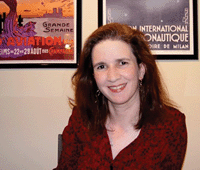With 2009, New Strides for SIAM on the Science Policy Stage
January 10, 2009

As a visitor at the December meeting of SIAM�s Committee on Science Policy, Mary Ann Horn of Vanderbilt University and the National Science Foundation took part in a panel discussion on interagency cooperation and related interdisciplinary research opportunities---linking, for example, computational scientists with experimentalists. Horn, who works in the Applied Mathematics and Mathematical Biology programs in NSF�s Division of Mathematical Sciences, was joined on the panel by Grace Peng of the National Institute of Biomedical Imaging and Bioengineering at NIH, and Tom Russell, representing the DMS Computational Mathematics program. Horn was elected in the fall to a seat on the SIAM Board of Trustees; her three-year term began on January 1.
SIAM's activities in the science policy arena have evolved over the last twenty some years, culminating this year with the appointment of Reinhard Laubenbacher as our first vice president for science policy. Laubenbacher, a professor at the Virginia Bioinformatics Institute and a professor of mathematics at Virginia Tech, dates his interest in science policy to the (2000) founding of VBI. Established to advance biotechnology research at Virginia Tech, VBI was funded initially with money from the tobacco settlements. It was his experience in that not always smooth but ultimately successful process, Laubenbacher says, that convinced him of the need to get involved in science policy. (He outlines some of his ideas for SIAM in the the accompanying article at http://www.siam.org/news/news.php?id=1519.)
For its part, SIAM traces its science policy involvement to the era of the first David Report (Renewing U.S. Mathematics). In 1983, then SIAM president Hirsh Cohen reported that "the appointment of mathematicians to keep the mathematical societies informed on federal activities in research, training, and education has been approved, with funding by the AMS, MAA, and SIAM." This was the beginning of the Joint Policy Board for Mathematics, which, for many years provided the SIAM community with its sole contact on science policy and science funding.
JPBM, also referred to as the "Washington Presence," became operational on January 1, 1984. Not long afterward, JPBM proposed the creation of the Mathematics Information Office. In December 1985, SIAM formed the Committee on Science Policy---to be, as recorded in the Board minutes, "the primary body for policy formulation vis-�-vis the Washington Presence."
For a time, JPBM had a paid staff. A mathematician (initially the late Kenneth Hoffman) served as the head; one staff person was hired to run the information program and another to handle congressional liaison.
SIAM and JPBM were not always in perfect harmony, especially in the 1980s. As recorded during one of many long and energetic discussions of the topic by the SIAM Board, "SIAM should have its own voice in Washington but continue to cooperate [with the rest of the mathematical sciences community] when it is appropriate to do so."
By 1997, JPBM was breaking down as the three member societies began to create their own activities in science policy, beginning with the AMS Washington Office. With the retirement of Richard Herman as JPBM chair, it was decided to retain only the congressional liaison and to rotate the position of chair among the member societies. When the congressional liaison left in 1998, a firm was hired to fill the void, but this arrangement proved only temporary. JPBM soon became what it is today: a body that coordinates activities of the member societies (which in 2004 expanded to include the American Statistical Association) in areas of common interest. Two ongoing projects that are reasonably consistent with the goals of the four member organizations are Mathematics Awareness Month and the annual JPBM Communications Award.
With the redefining of JPBM's reach, SIAM's Committee on Science Policy began to take on a more active role. Under the leadership of CSP chair Tom Manteuffel (2003�04), the CSP hired the Washington firm Lewis�Burke Associates to provide liaison with key policymakers in Washington. The CSP began to meet twice a year.
A typical meeting has two phases: a session with visitors from government agencies related to our discipline in the first phase, and visits to members of Congress (and more often staffers) in the second phase. Much of the activity has been intended simply to educate policymakers about the important role played by applied mathematics and computational science in advancing science and technology. One example is the CSP's support for NSF in its successful request for a Priority Area in mathematics. From time to time, the CSP responds to requests for information from various branches of government.
With our vice president for science policy in place, the CSP will take on a broader agenda and will try to involve the membership to a greater degree. One challenge issued by the Board to the CSP in creating the new position was to strengthen SIAM's support for the efforts of our international members.---JMC

